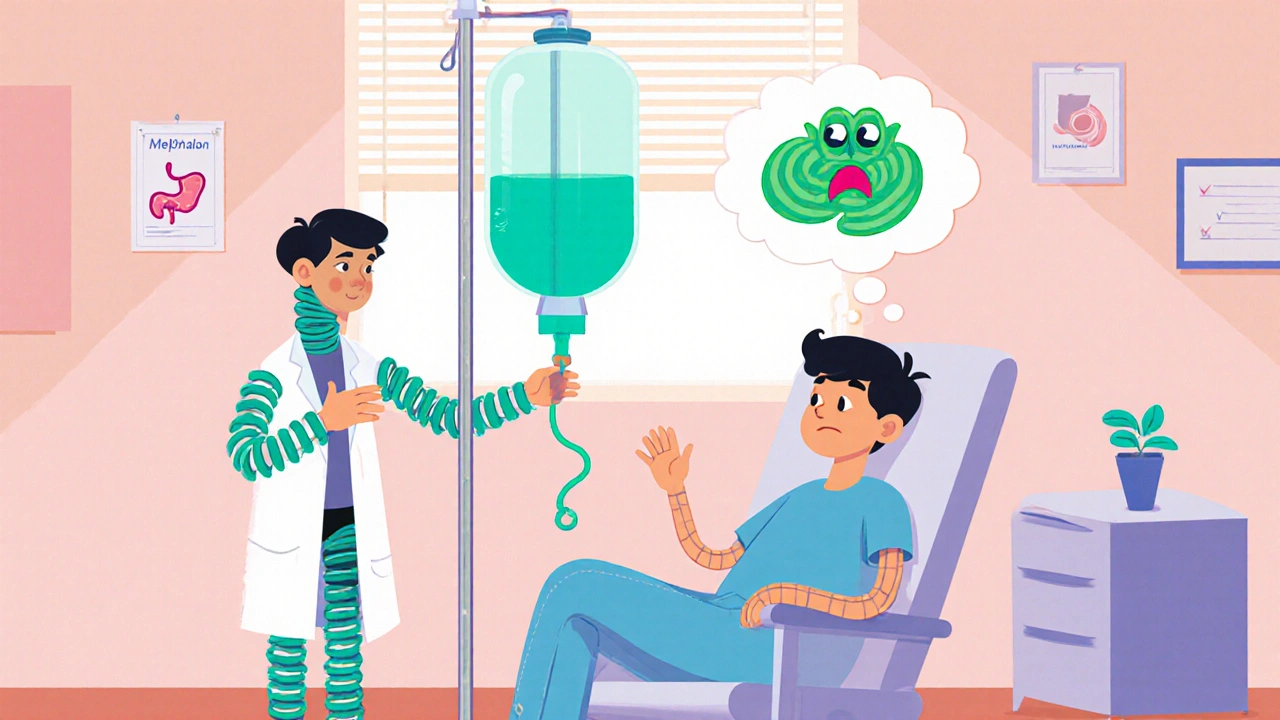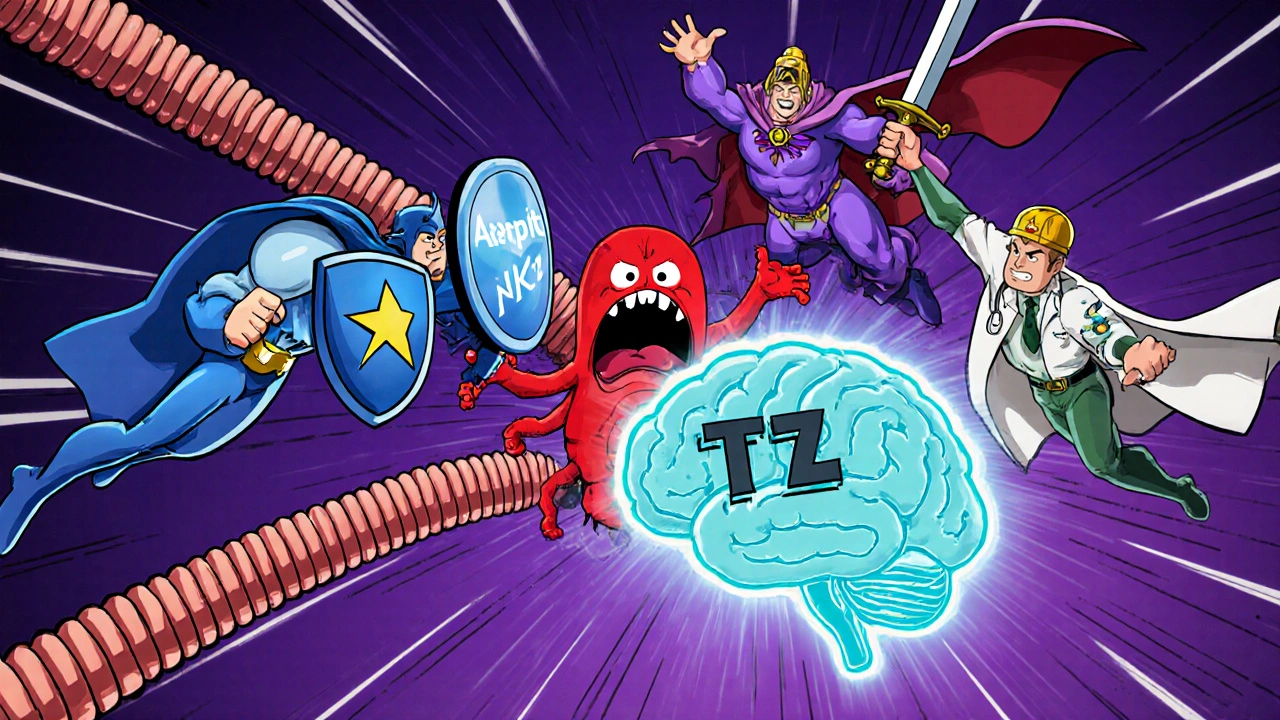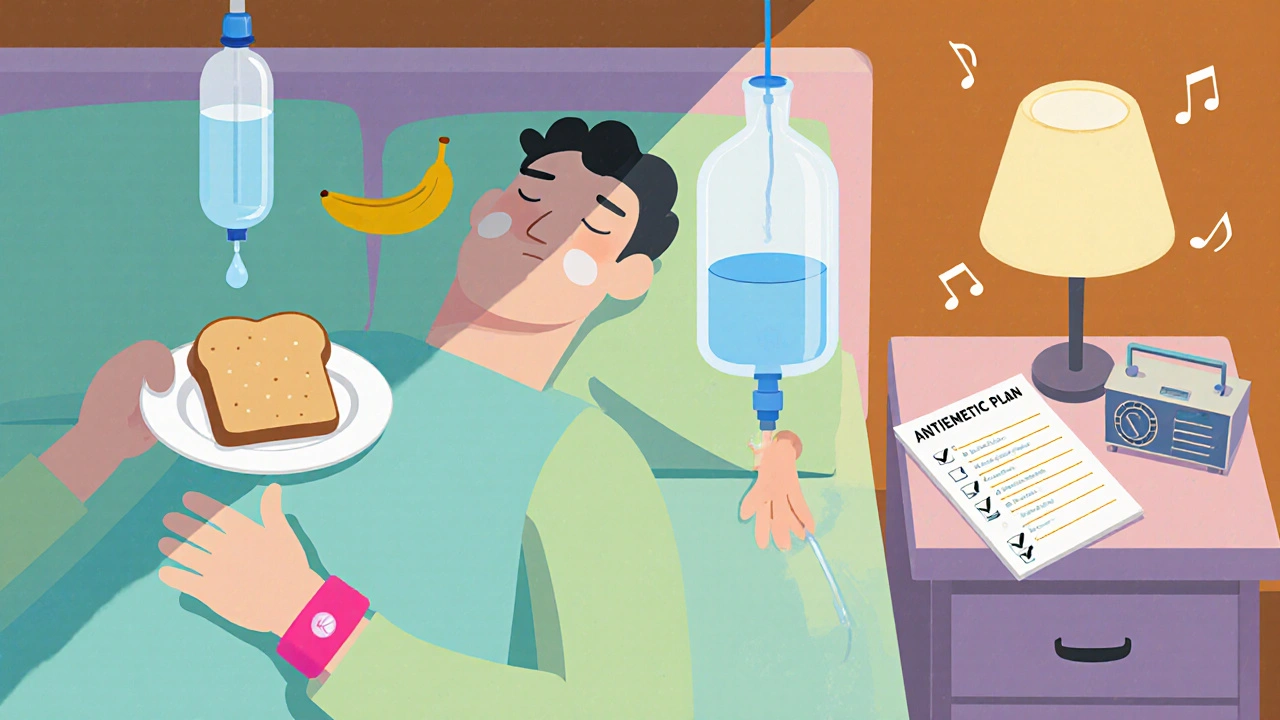Melphalan Chemotherapy Nausea: Prevention & Management Guide

Melphalan Nausea Risk Assessment Tool
Nausea Risk Assessment
This tool helps estimate your risk of nausea and vomiting during melphalan chemotherapy based on key factors. Results will show your risk level and appropriate prevention recommendations.
Your Risk Assessment
Patients receiving melphalan often ask, “Will I be sick?” The short answer is yes-melphalan is a high‑emetogenic drug, which means nausea and vomiting are common. But the good news is that modern oncology has a toolbox full of drugs and practical tricks that can keep those symptoms under control. This guide walks you through why melphalan triggers nausea, which patients are most at risk, and exactly what you can do before, during, and after treatment to stay comfortable.
What Makes Melphalan So Nauseogenic?
Melphalan is an alkylating agent used for multiple myeloma, ovarian cancer, and some solid‑tumor regimens. When it enters the bloodstream, it quickly reaches the chemoreceptor trigger zone (CTZ) in the brainstem and also irritates the gastrointestinal (GI) mucosa. Both pathways fire the same signal: a surge of serotonin and substance P that tells the vomiting center, “Throw up!” Because melphalan is administered intravenously in high doses, the spike in these neurotransmitters is intense, leading to both acute (within 24hours) and delayed (24‑72hours) nausea and vomiting.
Assessing Who’s Most Vulnerable
Not every patient will experience the same severity. Clinicians use a handful of risk factors to predict the need for aggressive antiemetic prophylaxis:
- Age: Younger patients (<55) tend to have more robust chemoreceptor responses.
- Gender: Women report higher rates of chemotherapy‑induced nausea and vomiting (CINV).
- History of motion sickness or prior CINV: Past experience is a strong predictor of future episodes.
- Alcohol consumption: Regular drinkers often have a blunted emetic response.
- Concurrent medications: Drugs that affect the CNS (e.g., opioids) can amplify nausea.
Documenting these factors before the first melphalan cycle helps the care team choose the right prophylactic regimen.
Pharmacologic Prevention: The Core Antiemetic Regimen
Guidelines from ASCO and NCCN categorize melphalan as a high‑emetic‑risk agent. The recommended backbone includes three classes of drugs:
- Ondansetron - a 5‑HT3 antagonist that blocks serotonin receptors in the CTZ.
- Aprepitant - a NK1 receptor antagonist that stops substance P from binding.
- Dexamethasone - a corticosteroid that potentiates the effect of both 5‑HT3 and NK1 blockers.
Typical timing looks like this:
- Day0 (chemo day): Ondansetron 8mg IV before melphalan, Aprepitant 125mg PO, Dexamethasone 12mg IV.
- Day1: Ondansetron 8mg PO every 8hours, Aprepitant 80mg PO, Dexamethasone 8mg PO.
- Day2-3: Continue Ondansetron 8mg PO every 12hours; consider a short taper of Dexamethasone.
For patients who cannot tolerate oral dosing, equivalents such as granisetron (IV) or intravenous NK1 antagonists (e.g., fosaprepitant) can be substituted.
Comparison of Common Antiemetic Regimens
| Regimen | Components | Administration Route | Key Advantages | Typical Side Effects |
|---|---|---|---|---|
| Standard Triple | Ondansetron + Aprepitant + Dexamethasone | IV (chemo day) → PO (days1‑3) | Highest efficacy; guideline‑backed | Constipation, fatigue, mild hyperglycemia |
| 5‑HT3+Dexamethasone Only | Ondansetron + Dexamethasone | IV/PO | Simpler, lower cost | Higher breakthrough rates (≈30%) |
| NK1+Dexamethasone Only | Aprepitant + Dexamethasone | PO | Useful for patients allergic to 5‑HT3 drugs | Potential drug‑drug interactions (e.g., CYP3A4) |
| Non‑Steroid Option | Ondansetron + Metoclopramide | IV/PO | Avoids steroids in diabetic patients | Extrapyramidal symptoms, drowsiness |
Choosing a regimen hinges on patient comorbidities, insurance coverage, and personal tolerance. The melphalan nausea rates drop from >70% to <15% when the full triple combo is used.

Non‑Pharmacologic Strategies That Really Help
Drugs are the backbone, but lifestyle tweaks add a big safety net:
- Hydration: IV saline before chemo and oral clear fluids (e.g., water, electrolyte drinks) after reduces GI irritation.
- Dietary modifications: Small, bland meals (toast, bananas, rice) 1hour before chemo; avoid fatty, spicy, or heavy foods.
- Acupressure wrist bands: The P6 point can cut nausea by up to 30% in controlled trials.
- Relaxation techniques: Deep breathing, guided imagery, or music therapy lower anxiety, a known trigger for CINV.
- Patient education: Knowing when to take rescue meds (e.g., prochlorperazine) empowers prompt action.
These tips are inexpensive, low‑risk, and can be tailored to cultural food preferences.
Managing Breakthrough Nausea and Vomiting
Even with optimal prophylaxis, some patients experience breakthrough episodes. The key is rapid rescue:
- First‑line rescue: Metoclopramide 10mg IV or PO every 15‑30minutes up to 30mg.
- If metoclopramide fails, switch to a dopamine‑free option such as Olanzapine 5mg PO.
- For severe vomiting, add a short‑acting benzodiazepine (e.g., lorazepam 0.5mg IV) to reduce anxiety‑mediated vomiting.
Document the time of rescue, dose given, and response. This data guides future prophylaxis tweaks-perhaps adding a second dose of NK1 antagonist on day2.
Monitoring, Follow‑Up, and When to Escalate Care
After each melphalan cycle, the care team should review a simple checklist:
- Did the patient experience any nausea or vomiting? Grade severity on a 0‑3 scale.
- Were antiemetics taken as prescribed? Note missed doses.
- Any new side effects from the antiemetics (e.g., constipation, dizziness)?
- Hydration status - urine output, weight change, electrolytes.
If nausea persists beyond day5, consider dose reduction of melphalan or referral to a palliative‑care specialist. Persistent vomiting can lead to electrolyte imbalances, so labs (potassium, magnesium) should be checked regularly.

Quick Reference Checklist for Clinicians and Caregivers
- Identify risk factors (age, gender, prior CINV).
- Start standard triple antiemetic regimen 30minutes before melphalan.
- Provide oral hydration and bland diet instructions.
- Give rescue medication at first sign of nausea.
- Document response and adjust on subsequent cycles.
Having a printed or digital copy on the bedside table keeps everyone on the same page.
Future Directions: Personalized Antiemetic Therapy
Research is moving toward genetics‑guided antiemetic choice. Polymorphisms in the TPMT and CYP2D6 genes affect how patients metabolize ondansetron and aprepitant. In the next few years, a simple blood test could tell you whether a patient needs a higher dose of NK1 antagonist or can skip the steroid. Until then, the guideline‑based triple regimen remains the gold standard.
Frequently Asked Questions
How soon before melphalan should I take the antiemetics?
All three drugs-ondansetron, aprepitant, and dexamethasone-are given at least 30minutes before the infusion starts. This timing lets the medicines reach peak blood levels when the chemotherapy hits the CTZ.
Can I skip the steroid if I have diabetes?
Yes, a steroid‑free regimen (ondansetron+aprepitant) can be used, but the anti‑emetic coverage may be slightly lower. Your oncologist might add a second dose of the NK1 antagonist or use metoclopramide as rescue.
What is the best diet on the day of treatment?
Eat a small, bland meal-think toast, plain crackers, banana, or oatmeal-about an hour before chemo. Avoid greasy, spicy, or high‑fiber foods that can irritate the stomach.
When should I call my doctor for vomiting?
If you vomit more than twice in an hour despite rescue meds, or if you notice dizziness, fever, or inability to keep fluids down, call the oncology unit immediately. Dehydration can become serious fast.
Are there any new drugs on the horizon?
Research into NK2 and serotonin‑4 antagonists is ongoing, but none are FDA‑approved for CINV yet. Genetic testing for drug metabolism may become routine, allowing dose‑fine‑tuning.
Rosalee Lance
October 16, 2025 AT 15:26When you stare into the abyss of chemotherapy, the abyss often stares back with a wave of nausea that feels almost conspiratorial, as if the drugs themselves are whispering a secret agenda to your gut. Yet the truth, stripped of paranoia, is simply pharmacology: melphalan floods the chemoreceptor trigger zone and drags serotonin into the spotlight, forcing the vomiting center to fire like an overzealous alarm. The philosophical lesson here is that our bodies are not passive vessels; they react with a chorus of chemical messengers that we can, with proper antidotes, quiet down. Modern antiemetics-5‑HT3 antagonists, NK1 blockers, and dexamethasone-act like diplomats, negotiating peace between the brainstem and the gastrointestinal epithelium. By pre‑medicating an hour before infusion, you give these diplomats a head start, preventing the storm before it even gathers clouds.
Age plays a mischievous role, younger patients tend to have a more robust emetic response, perhaps because their nervous systems are still tuned to react sharply to threats. Women, too, often report higher nausea scores, a fact some attribute to hormonal interplay, others to sociocultural conditioning. If you’ve ever felt that the hospital staff is hiding the best anti‑nausea regimen, remember that guidelines from ASCO and NCCN are publicly available, and most oncologists follow them closely-no hidden cabal, just evidence‑based practice.
Nutrition also matters: a light, bland meal an hour before treatment can provide a buffer, while greasy foods can amplify the revolt. Hydration is your ally; sip clear fluids between cycles to keep the mucosa moist and less prone to irritation. If delayed nausea strikes 24‑72 hours later, keep the rescue meds handy; don’t wait for the vomiting to start, because once the brain decides to vomit, it’s a cascade that’s harder to halt.
Finally, remember the mental component: anxiety can amplify the physical sensation, creating a feedback loop that feels like an endless conspiracy against you. Deep breathing, guided imagery, and even a brief walk can calm the central nervous system, reducing the signal that fuels the CTZ. In short, the combination of proper prophylaxis, dietary mindfulness, and psychological coping forms a triad that can tame the melphalan beast. Stay informed, stay prepared, and the nausea will be a manageable guest rather than an uninvited tyrant.
Kara Lippa
October 17, 2025 AT 19:20I love how you broke down the science into bite‑size pieces; it makes the whole anti‑nausea plan feel doable. Remember to keep a notepad of what works for you, so you can tweak the regimen with your nurse later. A little ginger tea or peppermint can be soothing, too. Stay positive, you’ve got this!
Puneet Kumar
October 18, 2025 AT 23:40From an inclusive perspective, it’s vital to recognize that cultural dietary habits influence antiemetic efficacy. Patients accustomed to spicy foods might experience heightened mucosal irritation, so adjusting spice levels pre‑infusion can reduce local inflammation. Additionally, the pharmacokinetic profile of melphalan suggests that a bimodal antiemetic schedule-one dose 30 minutes prior and a second 4 hours later-optimizes receptor blockade across both acute and delayed phases. Emphasizing patient education in native languages ensures adherence and improves outcomes across diverse populations.
michael maynard
October 20, 2025 AT 04:50Sure, the pharma giants want you sick so you keep buying their pills, but the truth is the anti‑nausea stack works if you follow the protocol. Don’t trust the “one size fits all” claim; ask for the NK‑1 blocker, it’s the hidden ace they don’t brag about.
Roger Bernat Escolà
October 21, 2025 AT 10:00Wow, reading all this feels like a rollercoaster of emotions-first the dread, then hope. I remember my first melphalan cycle; the nausea hit like a tidal wave. Having the right meds on standby saved me from days of being glued to the bathroom. Seriously, the simple act of keeping a mint candy nearby made a world of difference.
Allison Metzner
October 22, 2025 AT 15:10While the mainstream narrative paints antiemetics as mere side‑effects management, one must consider the elitist’s perspective: the real power lies in customizing the regimen beyond textbook recommendations. If you’re willing to navigate the labyrinth of clinical trials, you’ll discover bespoke protocols that outshine generic prescriptions.
Rajashree Varma
October 23, 2025 AT 20:20It’s encouraging to see such detailed guidance; knowledge truly is empowerment. Think of each anti‑nausea drug as a supportive friend cheering you on during the tough days. Together with mindfulness exercises, they form a holistic shield against melphalan’s assault. Keep the faith and stay gentle with yourself.
Anshuman Pandey
October 25, 2025 AT 01:30Indeed, the synergy between a 5‑HT3 antagonist and dexamethasone creates a pharmacodynamic partnership that significantly reduces emesis incidence. From a motivational standpoint, tracking symptom scores daily can provide data‑driven motivation, showing tangible improvement over successive cycles.
Thomas Malloy
October 26, 2025 AT 06:40Sounds good.
Sushma Gowda
October 27, 2025 AT 11:50Remember to breathe deeply between cycles; a calm mind can temper the body’s response. Hydration, light meals, and a positive outlook are your best teammates.
Angie Wallace
October 28, 2025 AT 17:00Good info helpful thanks
Doris Montgomery
October 29, 2025 AT 22:10The guide is decent but could use more practical tips on coping with delayed nausea.